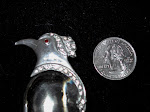When you are looking to buy vintage costume jewelry you will notice the term 'jelly belly' used to describe anything from colored cabochons to moonstones. When I first started in the business as an antique and vintage jewelry dealer I found this extremely confusing.
Collector's usually agree that in order to qualify as a true "jelly belly", the belly portion must be made of Lucite, not glass; and must be clear, not colored. The clear Lucite cabochon is the predominate feature of a pin. The most coveted pieces are larger pieces with Lucite set in sterling vermeil (gold washed sterling) which can be both beautiful and whimsical.
A jelly belly is a clear Lucite (thermoplastic acrylic resin) shape set in sterling silver or metal. Since "jelly bellies” all have a Lucite component, and Lucite was invented by DuPont in 1937, no “jelly bellies” are older than that. Jewelry historian Pat Seal said he doubted if any were made much before 1938 and the bulk of them were made during the war years of 1943-1945. The ones of that era were mounted in sterling silver settings. Sterling was rationed and very expensive, so adding a piece of Lucite to the design made it possible to produce large, eye-catching designs. After the war and into the 1950's they were made in base metals, but all of them are delightful!
Many costume jewelry manufacturers used the jelly bellies, but most famous are the Trifari and Corocraft sterling designs, which incorporated fantastic design with breathtaking quality of materials and craftsmanship. A story in circulation is that as part of their War efforts, Trifari installed Plexiglas windshield & turrets in military bombers. The company would only use flawless material. They were left with rejected material and rather than throw it away Alfred Phillipe had cabochons cut from the Plexiglas and incorporated them into jewelry designs.
Although Lucite isn't really considered a "specialty stone" it is harder to find and does have features that set it apart from regular cabs. For instance, it will sometimes be seen embedded with rhinestones or "reverse carved". Generally you can find examples in books on costume jewelry, one of which written by Roseann Ettinger entitled FORTIES AND FIFTIES COSTUME JEWELRY shows several jelly bellies and says they were originally created during the 1940s when the US could no longer import rhinestones, and many manufactures used clear Lucite to simulate rock crystal. I also have a couple displayed on my website at www.AntiqueJewelryCollectibles.com that you are welcome to take a look at.
Like all sought after vintage jewelry, jelly bellies have been copied both in large quantities and for private collections. These show up on the market, and though some can fetch good prices, in many cases they are not marked with a designer’s name (not all unsigned pieces are reproductions though). Also, most experienced sellers know that only the clear Lucite is true jelly bellies. Only inexperienced sellers or con-artists trying to get top dollar for an item would use the keyword Jelly Belly to describe colored Lucite or any kind of glass.
So, hopefully when someone asks you “what is a jelly belly anyway”, you’ll have a clear understanding just like the pros!
Contributed by:
Susan Busa of Bangles & Beads
www.AntiqueJewelryCollectibles.com
FOOTNOTE: There is a penguin with a jelly belly that has been faked. It is not one of the usual fakes that are done over and over, but was done specifically by a woman who had a large number of pieces from different designers faked. She did not make a large number of fakes from any one designer. She never meant the fakes to be sold. But when she died her son inherited them and has sold on and off on eBay for years, often changing his name. From what I understand, he sold all his fakes and one particular seller on e-Bay is now selling at least some of them.
Sunday, July 13, 2008
FOR THE ANTIQUE AND VINTAGE JEWELRY ENTHUSISTS
Labels:
Corocraft,
Figural Pins,
Lucite,
Trifari,
Vintage Jewelry

